Creating a bumper crop, whether growing plants in containers, in a traditional vegetable garden, or in a farmer's field, often depends on several basic factors. One of the first conditions for raising crops in abundance is that the plants chosen match the particular climate of the region for minimal maintenance and the best possible chance for them to mature completely within the season. Of equal importance are conditions like fertile soil, an adequate water supply, and enough hours of direct sunlight to ensure that the plants flourish before frost hits. Choosing crops also should be based on which plants grow well together and by taking into consideration using plants that can act as natural deterrents against pests and diseases that are common to the area. By basing plant choice on the local weather conditions and insect species, it is possible to minimize the need for chemical fertilizers, pesticides, and excessive labor and to grow more organically-based, healthy foods using a system that is known as integrated pest management.
Container gardening is one of the easiest and most cost-effective ways to have a small scale bumper crop. The practice is suited well to city residents who don't have access to land, and the growing season of plants in containers can be extended by keeping them warm as the fall frost approaches. The most essential facts to remember when growing vegetables in containers is that they get the proper amount of water, fertilizer, and sunlight, and that plants are chosen with shallow root systems suitable for confined spaces. A southern exposure is best for the most direct sunlight, and plants must be checked daily for any unusual signs of stress, such as a need for water. Containers offer the advantage that they can be moved around to follow favorable lighting and weather conditions, and the plants generally have less problems with insects and diseases than those in the ground do.

Planting crops in a vegetable garden involves the same basic requirements for a bumper crop in containers, with some special considerations to boost production. Vine-based plants like cucumbers and string beans should be trained to grow up vertical trellises to avoid wasting space on the ground. Perforated plant covers can be placed over plants at night to keep them warm and keep pests away, as well as using a mesh border to keep out rabbits and other nocturnal animals. Using natural fertilizer from compost will also release nutrients more slowly into the ground and encourage microbial and earthworm activity that makes nutrients more accessible to plants. Another important tip that can ensure a bumper crop in a vegetable garden is to use raised beds of soil several inches above the natural ground level, which can help the plants to stay warm and to ensure good drainage of moisture, as well as make them easier to prune and weed around.

If a larger gardening space or farmer's field is being used to grow a bumper crop, issues that need to be addressed include controlling naturally-invasive insect species, the use of hybrid seed for higher crop yields, and crop rotation of different types of plants year by year to keep the soil fertile. Integrated pest management handles these issues by encouraging populations of native insects to flourish or birds and bees, which can feed on harmful bugs and ensure good pollination. Companion planting can also be done to maximize the nutrient value of the soil and encourage pest control and pollination. Choosing plants that grow better in spring conditions versus others in the fall to grow side-by-side, or using plants with different maturity dates can ensure a bumper crop on smaller tracts of land in the farming industry.
